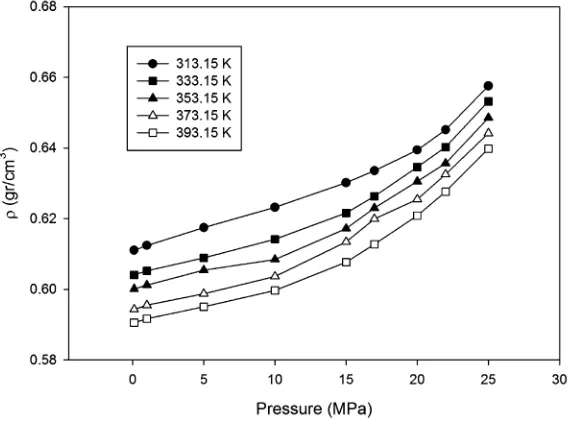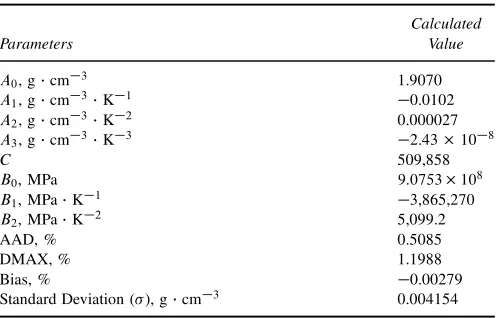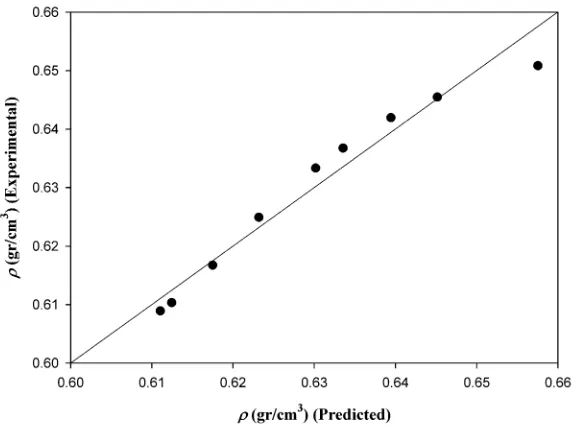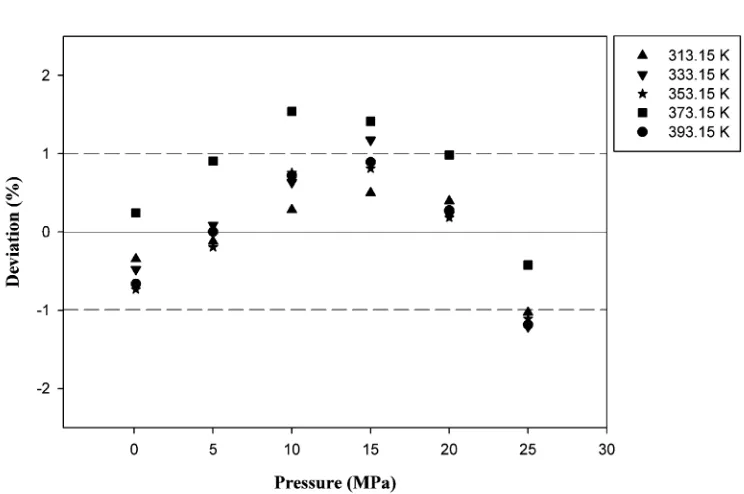This article was downloaded by: [New Mexico Tech - Skeen Library], [Munawar Khalil] On: 03 December 2012, At: 15:35
Publisher: Taylor & Francis
Informa Ltd Registered in England and Wales Registered Number: 1072954 Registered office: Mortimer House, 37-41 Mortimer Street, London W1T 3JH, UK
Petroleum Science and Technology
Publication details, including instructions for authors and subscription information:
http://www.tandfonline.com/loi/lpet20
A Tait-like Equation for Estimating
the Density of Nontraditional Super
Lightweight Completion Fluid at High
Pressure and Temperature
M. Khalil a , B. M. Jan a & A. A. A. Raman a
a Department of Chemical Engineering, Faculty of Engineering, University of Malaya, Kuala Lumpur, Malaysia
To cite this article: M. Khalil , B. M. Jan & A. A. A. Raman (2013): A Tait-like Equation for Estimating the Density of Nontraditional Super Lightweight Completion Fluid at High Pressure and Temperature, Petroleum Science and Technology, 31:1, 44-50
To link to this article: http://dx.doi.org/10.1080/10916466.2010.521791
PLEASE SCROLL DOWN FOR ARTICLE
Full terms and conditions of use: http://www.tandfonline.com/page/terms-and-conditions
This article may be used for research, teaching, and private study purposes. Any substantial or systematic reproduction, redistribution, reselling, loan, sub-licensing, systematic supply, or distribution in any form to anyone is expressly forbidden.
The publisher does not give any warranty express or implied or make any representation that the contents will be complete or accurate or up to date. The accuracy of any
DOI: 10.1080/10916466.2010.521791
A Tait-like Equation for Estimating the Density of
Nontraditional Super Lightweight Completion Fluid
at High Pressure and Temperature
M. Khalil,
1B. M. Jan,
1and A. A. A. Raman
11Department of Chemical Engineering, Faculty of Engineering, University of Malaya, Kuala Lumpur, Malaysia
Novel nontraditional super lightweight completion fluid (SLWCF) has been proven to be the best means to ensure the success of underbalance perforation. Field test showed that the application of this new fluid has improved the well productivity. The authors present density measurements of SLWCF at high pressure and temperature. Density values of the fluid were measured in laboratory at high temperature ranging from 313.15 to 393.15 K, and pressure up to 25 MPa. Measured densities were fitted to a Tait-like equation. Calculated absolute average deviation, the maximum deviation, bias, and standard deviation values show that the developed model can be used to express the fluid density over a wide range of pressure and temperature. In addition, density value predicted by a Tait-like equation shows a good agreement both with laboratory and field data.
Keywords: completion fluid, density, high pressure-temperature, Tait-like equation, underbalance per-foration
INTRODUCTION
It is no secret that the creation of perforation tunnel is always associated with perforation damage (Bartusiak et al., 1997; Ibrahim et al., 2009). This damage could impair fluid flow and decrease well productivity (Karacan and Halleck, 2003). The use of nontraditional super lightweight completion fluid (SLWCF) is considered one of the best means to provide a clean flow path between the wellbore and reservoir (Badrul et al., 2009). In our previous study, it has been reported that the use of the fluid has markedly increased well production rate threefold (Badrul et al., 2009).
Nevertheless, research works related to the nontraditional SLWCF is very scarce. The idea of formulating the SLWCF came from the needs to safely maintain the wellbore pressure lower than formation pressure (i.e., underbalance condition). Completing wellbore using low- to very low-density completion fluid can prevent perforation damage. Laboratory tests show that the
Address correspondence to B. M. Jan, Department of Chemical Engineering, Faculty of Engineering, University of Malaya, 50603 Kuala Lumpur, Malaysia. E-mail: badrules@um.edu.my
44
TAIT-LIKE EQUATION 45
density value of the SLWCF is reported to be less than 5.0 lbm/gal. Conventional synthetic oil– based completion fluid density is in the range of 7.0–8.0 lbm/gal (Khalil et al., 2010). In terms of its rheological properties, Khalil et al. (2010) reported that the fluid follows shear thinning (pseudoplastic) behavior, in which its flow properties could be described by the Mizhari-Berk model.
Recognizing the importance of completion fluid density in underbalance perforation, it is the objective of this paper to study the density of the SLWCF as a function of temperature and pressure. The experimental density values were measured at various temperatures and pressures ranging from 313.15 to 393.15 K (40–60ıC), and from 0.1 to 25 MPa (14.5–3,625.94 psi), respectively.
Experimental data were then fitted to a Tait-like equation to determine the relationship between density-pressure-temperature. The equation that was used to correlate the data is given by Eq. (1).
!.T; P /D !0.T /
1!Cln
! B.T /CP
B.T /C0:1MPa
" (1)
where!0.T / is the temperature dependence density at 0.1 MPa that is expressed as
!0.T /DA0CA1TCA2T2CAC3T3 (2)
Parameter C is assumed to be temperature independent, and B.T / is given by the following polynomial function:
B.T /DB0CB1T CB2T2 (3)
EXPERIMENTAL METHOD
Formulation of the Nontraditional SLWCF
The nontraditional SLWCF was prepared based on our previous study (Badrul et al. 2009). The fluid consists of shell sarapar oil as continuous synthetic oil–based completion fluid, 3M hollow glass bubbles as a density reducing agent, and appropriate homogenizing and stabilizing agents. The amount of sarapar oil and glass bubbles was fixed at 65% and 35% by weight, respectively. The amount of homogenizing agent and additives was set at 4% and 10% by weight, respectively. All of the raw materials were mixed using IKA T25 digital ultra-turrax disperser (IKA, Wilmington, NC) for an hour at 14,000 rpm.
Density Measurement
In this study, SLWCF density was measured using a high-pressure Anton Paar DMA (Anton Paar GmbH, Ostfildern, Germany) HP high-pressure vibrating tube densimeter equipped with DMA 4500 as the evaluation unit. To pressurize and introduce the sample into the DMA, a high-pressure volumetric hand-pump (model HPT1, rating: 10,000 psi; Si Pressure Instruments Ltd., Birmingham, UK) equipped with GE Druck DPI 104 manometer was used. To monitor the pressure during the measurement, a digital pressure transducer (Swagelok S Model transducer, rating: 0– 8,000 psi) was used. Density data at experimental range were then fitted to Tait-like equation (Eq. [1]) using the SAS software version 9.2 (SAS Institute, Cary, NC). Tait-like equations parameters and the absolute average deviation (AAD), the maximum deviation (DMAX), the average deviation
RESULTS AND DISCUSSIONS
The density of SLWCF at high pressure and temperature is very important especially in deep and hot wells. At this condition, expansion due to temperature and compression due to pressure might alter fluid’s density. Thus its downhole densities may be quite different compared with its surface density. In general, temperature reduces the density of material. Pressure on the other hand increases the density of a material. Numerous researchers have studied the effect of pressure and temperature on the density of fluid used in petroleum exploration and production. These studies include investigations on densities of water- and oil–based muds, drilling fluid, and mineral-oil-based muds. However, the studies on the effect of pressure and temperature on SLWCF to achieve underbalance condition is very scarce.
To optimize the Tait-like equation’s parameters for the nontraditional SLWCF, a wide range of density values at various temperature and pressure were examined. Measured density values of the SLWCF are presented in Table 1. Based on the results, fluid density is directly proportional to pressure and inversely proportional to temperature. Density measurements were conducted at temperature and pressure ranging from 313.15 to 393.15 K and from 0.1 to 25 MPa, respectively. Figure 1 shows the densities of nontraditional SLWCF as a function of temperature at various pressures. As predicted, density decreases with the increase of temperature. Similar to other petroleum fluid, thermal energy decreases the density of fluid by reducing the attractive force between molecules in the fluid. Results also showed that in the tested temperature interval, density reduction is linear with temperature.
Figure 2 shows the variation of SLWCF density as a function of pressure at various tem-peratures. In isothermal condition, at lower pressure (pressure below 15 MPa), the relationship between density and pressure is linear. However, at high pressure (pressure above 15 MPa), the increase of fluid density is more profound. This phenomenon may be due to the breakage of some of the glass bubbles at high pressure.
A Tait-like equation has successfully been used to correlate the density of certain fluid within a wide range of pressure and temperature. It has been used to describe the relationship of density-temperature-pressure on simple and complex fluids (Milhet et al., 2005; Miyake et al., 2008).
[image:4.504.115.374.529.667.2]Currently there is no previous study that has used Tait-like equation to describe density as a function of temperature and pressure in fluids commonly found in the upstream petroleum industry, such as drilling, completion, and fracturing fluids. One of the widely used models used to predict the density of fluid in petroleum industry was developed by Kutasov (1988). In his
TABLE 1
Experimental Densities of Super Lightweight Completion Fluid (SLWCF) and!(g/cm3) at Various Temperatures (T) and Pressure (P)
Temperature, K Pressure,
MPa 313.15 333.15 353.15 373.15 393.15
0.1 0.6110 0.6041 0.6001 0.5943 0.5906 1 0.6124 0.6053 0.6012 0.5955 0.5917 5 0.6175 0.6089 0.6054 0.5988 0.5951 10 0.6232 0.6141 0.6085 0.6037 0.5996 15 0.6302 0.6216 0.6172 0.6135 0.6077 17 0.6335 0.6263 0.6230 0.6199 0.6128 20 0.6394 0.6346 0.6305 0.6255 0.6208 22 0.6451 0.6402 0.6356 0.6325 0.6276 25 0.6575 0.6532 0.6485 0.6441 0.6398
TAIT-LIKE EQUATION 47
FIGURE 1 Variation of lightweight completion fluid’s densities as a function of temperature at different pressure.
study, an exponential function was proposed to describe the empirical relationship of drilling mud density to pressure and temperature. In a study conducted by Babu (1993), a model was used to represent the measured data of water-based mud during deep well drilling. Another mathematical model was developed by Kårstad and Aadnøy (1998) to evaluate the density behavior of drilling fluid. In their study it is assumed that the initial temperature and pressure conditions.P0; T0/is
[image:5.504.118.403.439.651.2]equal to surface conditions.Psf; Tsf/. However, this assumption might not be valid if the surface temperature is high.
To determine the efficiency of the fitting, measured experimental densities data was compared to values derived from the Tait-like correlation. AAD, DMAX, the average deviation (bias), and the standard deviation s were calculated using the following equations:
AADD 100 N
N
X
iD1
ˇ ˇ ˇ ˇ
!expi !!calc ı
!expi
ˇ ˇ ˇ ˇ
(4)
DMAXDmax
! 100 ˇ ˇ ˇ ˇ
!expi !!calc ı
!iexp
ˇ ˇ ˇ ˇ " (5)
biasD 100 N
N
X
iD1
!expi !!ıcalc
!iexp (6)
"D v u u u u t N X
iD1
.!expi !!calcı /2
N !m (7)
whereN indicates the number of experimental data points and m is the number of calculated parameters.
[image:6.504.173.440.163.331.2]Based on the fitting, the eight calculated Tait-like equation parameters are presented in Table 2, along with the AAD, DMAX, bias, and standard deviation ("). The results also show that the standard deviation is in the same order of magnitude as the experimental uncertainty. This suggests that with the use of a Tait-equation it is possible to interpolate and predict the density of SLWCF at any pressure and temperature.
Figure 3 shows the comparison of the SLWCF experimental density values and predicted density values calculated using the Tait-like equation at 313.15 K. It is apparent that all of the
TABLE 2
Calculated Tait-like Equation Parameters for Super Lightweight Completion Fluid and Deviations for the Density Correlation
with Tait-like Equation
Parameters
Calculated Value
A0, g!cm!3 1.9070
A1, g!cm!3!K!1 "0.0102
A2, g!cm!3!K!2 0.000027
A3, g!cm!3!K!3 "2.43#10!8
C 509,858
B0, MPa 9:0753#108 B1, MPa!K!1 "3,865,270
B2, MPa!K! 2
5,099.2
AAD, % 0.5085
DMAX, % 1.1988
Bias, % "0.00279 Standard Deviation ("), g!cm!3 0.004154
[image:6.504.120.369.507.666.2]TAIT-LIKE EQUATION 49
FIGURE 3 Comparison of experimental and predicted density values of nontraditional super lightweight completion fluid at 313.15 K.
points sit on the straight line indicating that the predicted values are in a good agreement with the experimental data. In addition, the deviations between the experimental and predicted values were also determined. The deviation was calculated as100".1!#Experimental=#Predicted/. Figure 4 presents the deviation between the fluid densities measured in the lab and calculated from the Tait-like equation. Based on the results, it is also shown that the predictions are in a good agreement with the experimental data. The deviation is essentially low in the range of˙1%.
In this study, the laboratory-based study to predict the SLWCF density data on wide range of pressure and temperature results was also compared to field data. Based on our previous field test study at 2,058.3 m underground, the density of SLWCF that was used to perforate the well is 0.6273 g/cm3 at 2,000 psi (13.78 MPa) and 240ıF (388.70 K; Badrul et al. 2009). Meanwhile,
the density value calculated from the Tait-like equation is 0.6191 g/cm3. Based on the result, the accuracy between the predicted density value calculated using a Tait-like equation and the experimental value is 98.69%. This indicates that the predicted value is in a good agreement with the experimental density value.
CONCLUSIONS
The density of nontraditional SLWCF has been determined over a pressure range of 0.1–25 MPa and temperature range of 313.15–393.15 K. These data were then fitted to the Tait-like equation to correlate density-pressure-temperature relationships. The result indicates that the Tait-like equation can be used to correlate densities of the nontraditional SLWCF over a wide range of pressure and temperature. In addition, the results also show that the predicted SLWCF density values are in a good agreement with the experimental data with very low deviation in the range of ˙1%. The predicted value is also found to be in a good agreement with field data. The corresponding
FIGURE 4 Deviation between experimental and predicted density values of nontraditional lightweight comple-tion fluid.
REFERENCES
Babu, D. R. (1993). Effect ofP"!"T behavior of water muds on static pressures during deep well drilling.J. Pet. Sci. Eng. 9:341–349.
Badrul, M. J., Rae, G. R., Noor, M. I., Suhadi, A. N., and Devadaas, M. (2009). Increasing production by maximizing underbalance during perforation using nontraditional lightweight completion fluid. SPE Drilling Complet.24:326–331. Bartusiak, R. M., Behrmann, L. A., and Halleck, P. M. (1997). Experimental investigation of surge flow velocity and
volume needed to obtain perforation cleanup.J. Pet. Sci. Eng. 17:19–28.
Ibrahim, H., Harrasi, A., Salsman, A., Nunez, A. J., and Situmorang, H. (2009). Novel perforating job design triples well productivity. SPE 119639,2009 SPE European Formation Damage Conference, Oklahoma City, Oklahoma, April 4–8. Karacan, C. O., and Halleck, P. M. (2003). Comparison of shaped-charge perforating induced formation damage to
gas-and liquid-saturated sgas-andstone samples.J. Pet. Sci. Eng. 40:61–75.
Kårstad, E., and Aadnøy, B. S. (1998). Density behavior of drilling fluids during high pressure high temperature drilling operations. SPE 47806,IADC/SPE Asia Pacific Drilling Technology Conference, Jakarta, Indonesia, September 7–9. Khalil, M., Badrul, M. J., and Aziz, A. R. (2010). Rheology of nontraditional lightweight completion fluid and its
dependence on temperature.J. Pet. Sci. Eng. 77:27–33.
Kutasov, I. M. (1988). Empirical correlation determines downhole mud density.Oil Gas J.. 86:102–104.
Milhet, M., Baylaucq, A., and Boned, C. (2005). Volumetric properties of 1-phenyldecane and 1-phenylundecane at pressure to 65 MPa and temperature between 293.15 and 353.15 K.J. Chem. Eng. Data. 50:1430–1433.
Miyake, Y., Baylaucq, A., Plantier, F., Bessières, D., Ushuki, H., and Boned, C. (2008). High-pressure (up to 140 MPa) density and derivative properties of some (Pentyl-, Hexyl-, and Heptyl-) amines between 293.15 and 353.15 K.J. Chem. Thermodynam.40:836–845.




